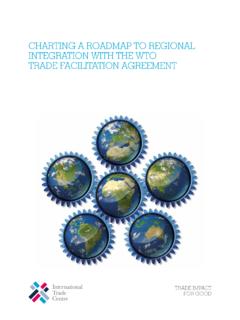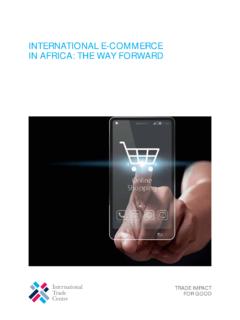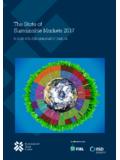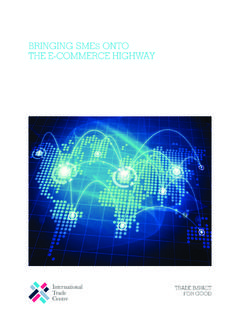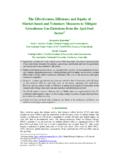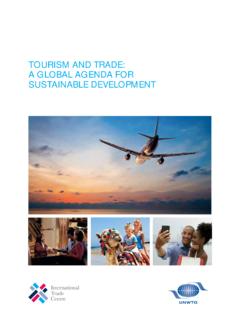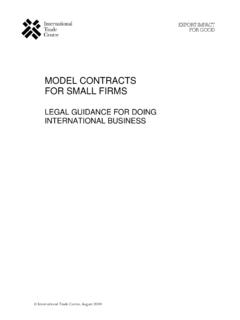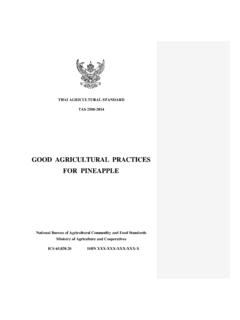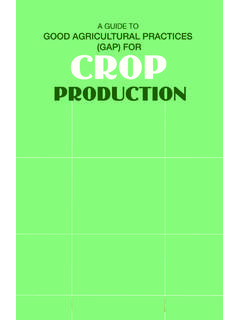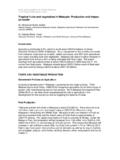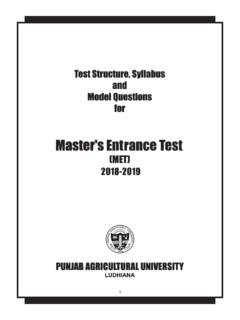Transcription of National Mango Study - ITC
1 GHANA National Mango Study By Mr Abdallah Khalifa Zakari With the support of the PACT II program & the International Trade Centre (Geneva) April l 2012 1 TABLE OF CONTENTS INTRODUCTION _____ 6 1 THE FRESH Mango VALUE CHAIN _____ 7 Actors and stakeholders of the fresh Mango value chain in Ghana _____ 7 Producers and exporters of mangoes _____ 7 Trade Promotion Organisations _____ 11 Input suppliers _____ 13 Mapping and description of the fresh Mango value chain _____ 14 Bottlenecks hindering the competitivity of the fresh Mango value chain _____ 16 Past and ongoing interventions to improve the fresh Mango value chain _____ 18 Evaluation of the Mango demand _____ 21 Mango market size and market share _____ 22 Traded Mango volumes from Ghana for the last 5 years _____ 26 Mango pricing _____ 27 Local and regional markets for fresh mangoes _____ 28 Market access requirements _____ 29 Market promotion
2 Activity, participation in trade fairs _____ 29 Supply potential assessment of the value chain to meet demand _____ 30 Production volumes and availability _____ 30 SWOT analysis of the fresh Mango value chain in Ghana _____ 32 Conclusion and recommendations _____ 33 2 THE VALUE CHAIN OF PROCESSED Mango PRODUCTS _____ 35 Actors involved in juice processing _____ 35 Mango producers _____ 35 Juice processing companies _____ 35 Packaging companies _____ 37 Other actors _____ 37 Mapping and description of the value chain and the challenges inherent _____ 38 Evaluation of demand _____ 39 Market access requirements _____ 40 Mango juice pricing _____ 40 2 Supply potential assessment of the Mango juice sector _____ 40 SWOT analysis for the Mango juice value chain _____ 41 Conclusions and recommendations _____ 41 Opportunity identification and follow-up: _____ 42 Increasing productivity of processing units: _____ 42 Improving processors capacities to meet specifications of potential markets: _____ 42 3.
3 THE DRIED Mango VALUE CHAIN _____ 43 Actors along value chain of dried Mango _____ 43 Mapping and Description of the value chain and the associated bottlenecks _____ 45 Demand evaluation of dried Mango _____ 46 Pricing and Market access requirements _____ 46 Supply potential of the dried Mango value chain _____ 47 SWOT analysis of dried Mango chain _____ 47 4. GENERAL CONCLUSIONS AND RECOMMENDATIONS FOR ECOWAS TEN / AREAS OF INTERVENTIONS _____ 48 General recommendations _____ 48 5. MAIN CONSTRAINTS AFFECTING THE Mango SECTOR IN GHANA _____ 50 Market access issues _____ 50 Logistics and infrastructures _____ 50 Production _____ 50 Processed Mango products _____ 50 6 PROJECT BRIEF IDEAS/PROPOSITIONS OF INTERVENTIONS FOR THE Mango SECTOR _____ 51 Interventions within the Mango sector in general _____ 51 A Mango Competitiveness Fund _____ 51 Mango practices community.
4 _____ 51 Mango Export Quality guidebook for Ghanaian and ECOWAS exporters _____ 52 3 Interventions within the Mango juice sector _____ 52 Opportunity identification and follow-up _____ 52 Increasing productivity of processing units _____ 52 REFERENCES _____ 54 Annex 1 - EDIF Brokers Mango Marketing Deal_____ 56 Annex 2 Major Mango production & processing areas _____ 57 4 LIST OF ACRONYMS AND ABBREVIATIONS ADB agricultural Development Bank ADRA Adventist Development and Relief Agency ADVANCE agricultural Development and Value Chain Enhancement Project AfDB African Development Bank AGOA African Growth and Opportunity Act AgSSIP agricultural Services Sub-Sector Investment Programme CEPS Customs Excise and Preventive Services COLEACP Comit pour Liaison Europe ACP EC European Commission ECOWAS Economic Community of West African States ECOWAS-TEN ECOWAS Trade and Enterprises Network EDIF Export Development & Investment Fund EMQAP Export Marketing and Quality Awareness Project ESSD Environmentally & Socially Sustainable Development Network ETLS ECOWAS Trade Liberalization Scheme EU European Union FAGE Federation of Associations of Ghanaian Exporters FBO Farmer Based Organisation FMSL Farm Management Services Limited GAP General agricultural Practices GEPA Ghana Export Promotion Authority GhIH Ghana Institute of Horticulturists GIPC Ghana Investment Promotion Centre GIS Geographical Information Systems GLOBALGAP Global Good agricultural Practice 5 GSB Ghana Standards Board GTZ German Government Agency for International Cooperation
5 HAG Horticultural Association of Ghana HEII Horticultural Export Industry Initiative ITC International Trade Centre ITFC Integrated Tamale Fruit Company MCA Millennium Challenge Account MIDA Millennium Development Authority MOFA Ministry of Food and Agriculture MOTI Ministry of Trade and Industry NAFDAC National Agency for Food and Drug Administration and Control NGO Non-Governmental Organisation NHTF National Horticultural Task Force PAMPEAG Papaya and Mango Producers Exporters Association Ghana PIP Pesticides Initiative Programme PPRSD Plant Protection & Regulatory Services SPEG Sea-Freight Pineapple Exporters of Ghana SSA Sub- Saharan Africa TIPCEE Trade Investment Program for a Competitive Export Economy TIRP Trade and Investment Reform Programme UAE United Arab Emirate UNIDO United Nations Industrial Development Organisation USAID United States Agency for International Development VEPEAG Vegetable Producers and Exporters Association of Ghana VOMAGA Volta Mango Growers Association 6 INTRODUCTION In the last 20 years, Ghana has developed its exports of fresh produce to Europe and other destination markets, although earnings have been undulating.
6 Total earnings from fresh edible fruits in 2003 amounted to about US$ 44 million, US$ 144 million in 2006 and dropped to about US$ 23 million in 2010, mainly due to the Ghanaian pineapple loosing substantial market shares against Costa Rican suppliers in Europe. Pineapples, mangoes and papayas lead the fruit exports while yams, chillies and Asian vegetables (aurbergines, okra, etc) head the shipments of vegetables. These non-traditional agriculture exports make a notable contribution to the economy in terms of employment, fiscal revenues and foreign exchange. As a result, policy makers and development partners have looked to support horticulture exports as a diversification mean of the export base and an opportunity to improve rural livelihoods.
7 In 1998 the World Bank and the Ministry of Food and Agriculture (MOFA), commissioned a short Study of the sector in order to assess the opportunities, identify constraints and suggest strategies and infra-structural improvements to take fresh produce exports forward. A similar exercise was conducted in 2003 as part of the restructuring of the World Bank-funded agricultural Services Sub-Sector Investment Programme (AgSSIP) within MoFA. This second appraisal of the industry led to the development of a strong horticultural component to the AgSSIP under the title Horticultural Exports Industry Initiative (HEII) within (MoFA). Since 2003 the horticultural export sector in Ghana has lost market share to competing countries such as Costa Rica after Chiquita introduced the MD2 pineapple variety in the European market.
8 The slump in pineapples, the leading product in the horticulture export portfolio, affected the entire fruit exports sector. Although the pineapple segment continues to dominate the horticultural export portfolio of the nation, Mango is projected to make significant contribution to the basket in the foreseeable future. Recent development within the Mango sector has raised considerable interest among economic analysts, such as the Export Development and Investment Fund efforts to implement a US$ 50 million Mango plantation project in the Northern Region. Interventions by technical and donor institutions such as United Stated Agency for International Development (USAID) through the Trade and Investment Project for a Competitive Export Economy (TIPCEE), have led to structuring of the sector.
9 At the same time, market diversification strategies are being championed by actors such as the Ghana Export Promotion Authority (GEPA) with the view to moving away from Ghana s traditional market, which is the European market. This Study takes into cognizance the value chain of mangoes from production to exports. In this vein, the value chain of fresh mangoes as well as that of transformed and dried ones were looked at extensively, assessing the main actors, past and ongoing interventions in the sector, problems militating against each value chain segment and a host of other factors. Notable operators that have been profiled in this work include Blue Skies, Sunripe, Ebenut and FMSL. It should also be emphasized that this work falls in line with the strategic objective of the ECOWAS Commission to streamline and strategically position flagship agricultural products within the sub-region of which Mango is one.
10 Realizing this significance, the Commission with technical support from the International Trade Centre (ITC) embarked on a policy that will see to the development of a strategy document for the entire region. This work therefore is in furtherance to that objective. It will augment similar works being undertaken in Nigeria, Mali, Burkina Faso and Cote d Ivoire. 7 ASSESSING Mango VALUE CHAINS IN GHANA 1 THE FRESH Mango VALUE CHAIN Compared to other West African origins, the presence of fresh mangoes from Ghana on international markets is relatively modest, amounting to less than 3% of EU imports in terms of volumes supplied from ECOWAS countries. However, fresh-cut mangoes from Ghana have made important inroads in the last 10 years, adding value to the product and directly impacting the National economy in terms of income generation and employment creation.
